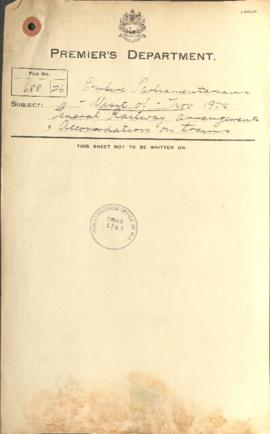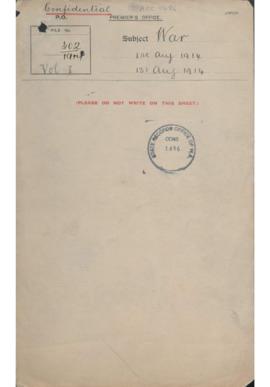Identity area
Reference code
Title
Date(s)
- 1898-05-01 - (Creation)
- 1894-01-01 - 1997-01-17 (Accumulation)
Level of description
Medium
Format
Status
Context area
Name of creator
Administrative history
With the advent of responsible government in 1890, the Governor was superseded as the Chief Executive Officer of Western Australia by a Premier and Cabinet who were responsible to Parliament. The first Premier was the Hon. John (afterwards Sir John and later Baron) Forrest, who held the position until 1901. Premier Forrest's office was managed by Frederic D. North, a clerk from the Crown Lands Office who was appointed Secretary and Clerk to the Executive Council in February 1891. North may be regarded as the instigator of the Premier's Department since it was his submission to Forrest which led to the creation of the Department in May 1898.
At its inception, the Department consisted of North (who was styled "Under Secretary"), a shorthand clerk, a records clerk and a messenger. When the Department was first established in 1898 it was gazetted as a sub-department of the Treasury. In July 1901 it became a sub-department of the Attorney-General's Department. A year later it became a sub-department of the Colonial Secretary's Department.
In August 1903 the title of the Premier's "Department" was changed to Premier's "Office", and during the next few years the office was located within the Departments held in the portfolio of the Premiers of the day.
In 1907, the Premier's Secretariat was recognized as a separate entity and was allocated its own appropriation. For the next 34 years it functioned as an autonomous government Department.
In August 1941 it reverted to being a sub-department of the State Treasury. However, its status was restored in January 1948 and since then it has functioned as an independent Department. The changing status names and affiliations of the Department may be summarized as follows:
- May 1898: Premier's Department - sub-department of the Colonial Treasury;
- July 1901: Premier's Department - sub-department of the Attorney-General;
- July 1902: Premier's Department - sub-department of the Colonial Secretary's Office;
- August 1903: Premier's Department - located within various departments, mainly Treasury;
- January 1907: Premier's Office - autonomous department;
- August 1919: Premier's Department - autonomous department;
- August 1941: Premier's Office - sub-department of State Treasury;
- January 1948: Premier's Department - autonomous department.
On 1 September 1987 the Department was reorganized and its name changed to the Ministry of the Premier and the Cabinet.
The organisation is known now as the Department of the Premier and Cabinet.
Just as the name of the Department changed, so too did the title of Departmental Heads. The permanent Head of the Department was known variously as "Under Secretary, Premier's Department" (1898-1903); "Secretary to the Premier" (1903-1919); "Secretary, Premier's Department" (1919-1936); "Under Secretary, Premier's Department" (1936-1941); "Secretary, Premier's Office" (1941-1947); and "Under Secretary, Premier's Department" (1948-1987).
In 1917 the Premier's Department assumed responsibility for the office of the Agent-General in London. The Department subsequently administered other agencies including the Government Motor Car Service, Government Printer, Public Service Commission, Railway Advisory Board and the State Gardens Board (afterwards known as the National Parks Board). During the Second World War, when the National Security Act vested the Premier with wide powers, the Department was responsible for such matters as blackouts, hotel hours, race meetings and basic wages.
Later, the Department was to hold responsibility for Royal Commissions and other Commissions of Inquiry, for protocol and for the appointment of Justices of the Peace. As well as providing secretarial and administrative assistance to the Premier and the Executive Council, the Department acted as a liaison between the Government and the Governor and between the Legislature and the Judiciary.
Name of creator
Administrative history
Following the formation of the Burke administration in February 1983, the Premier's Department was restructured and retitled as the Department of the Premier and Cabinet. The title of the Permanent Head of the Department was upgraded from Under Secretary to Director General. The Department comprised three divisions: Policy; Administrative Services, and; Ceremonial and Hospitality. Each division was headed by an Executive Director who reported to the Deputy Director General and the Director General.
As well as providing executive and administrative support to the Premier and the Cabinet, the Department was responsible for the Government Media Office and the Agent General's Office in London. The Department was also responsible for Royal and other Commissions of Inquiry and for various advisory bodies such as the Equal Opportunity Commission and the Women's Advisory Council. In September 1987 the Department was renamed the Ministry of the Premier and Cabinet.
Name of creator
Administrative history
Repository
Archival history
Content and structure area
Scope and content
Registered files which comprise correspondence between the Premier and his Ministers, State and Commonwealth Governments, other organisations and individuals.
The files also cover a range of matters relating to the administration and operations of this department.
(Files in this Record Series include items which were previously listed at the State Records Office at reference: AN 2, Accession 1496; AN 2/9, Accession 1703 and part of Accession 1704).
Accruals
System of arrangement
Conditions of access and use area
Conditions governing access
Conditions governing access (legacy)
Conditions governing reproduction
Language of material
Script of material
Language and script notes
Physical characteristics and technical requirements
Finding aids
Allied materials area
Existence and location of originals
Related units of description
Authorized form of name
Identifier
Category of relationship
Description of relationship
Dates of relationship
Authorized form of name
Identifier
Category of relationship
Description of relationship
Dates of relationship
Authorized form of name
Identifier
Category of relationship
Description of relationship
Dates of relationship
Related units of description
Access points
Place access points
Description control area
Level of detail
Language(s)
Script(s)
Sources
Archivist's note
Copies: Microfilm of Cons 1496 to 1900 is available at the State Records Office of Western Australia. Copies of some files from Consignment 5761, relating to John Curtin, are now available in digital format via the Electronic Research Archive at the John Curtin Prime Ministerial Library http://john.curtin.edu.au/resources/index.html







